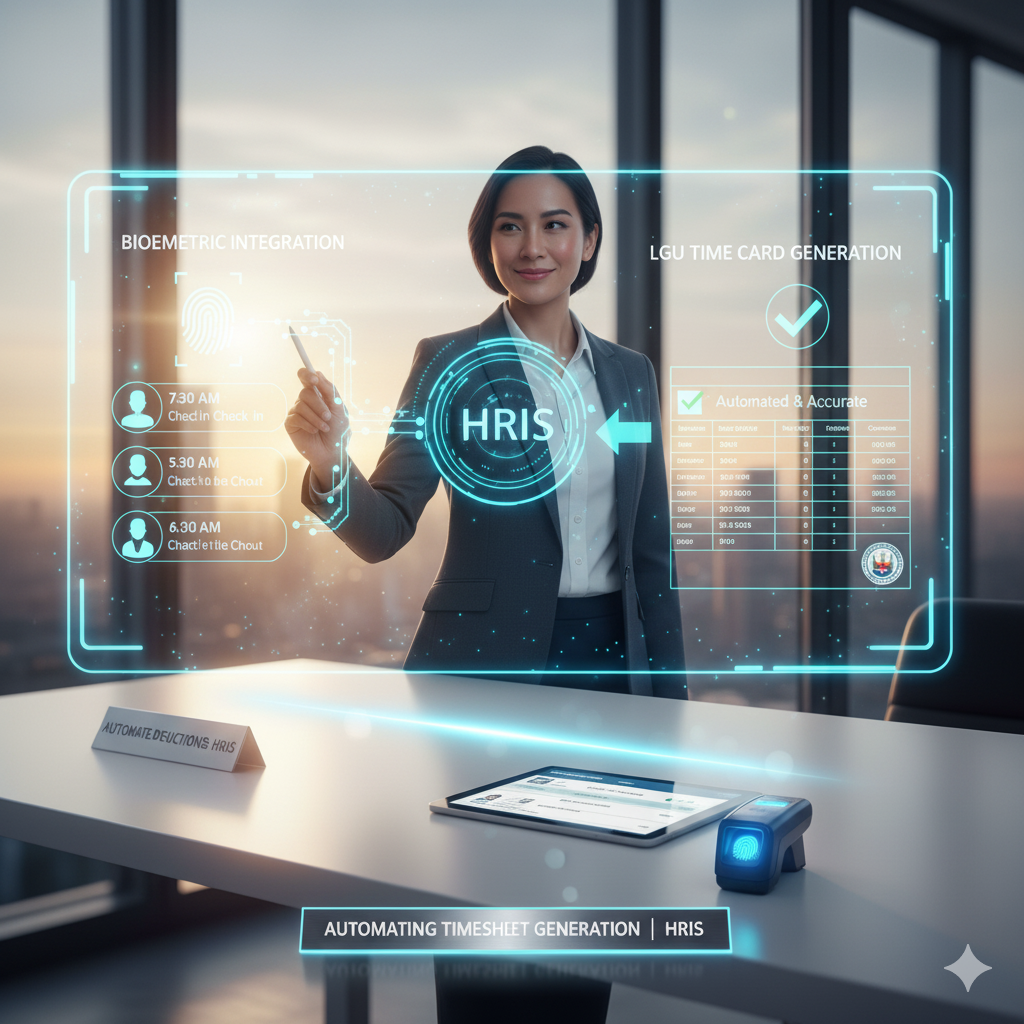Address
Kaypian, San Jose Del Monte City, Bulacan Philippines
Work Hours
Monday to Friday: 8AM - 6PM
Weekend: 10AM - 5PM
Address
Kaypian, San Jose Del Monte City, Bulacan Philippines
Work Hours
Monday to Friday: 8AM - 6PM
Weekend: 10AM - 5PM


Integrated HR. Accurate Payroll.


Integrated HR. Accurate Payroll.

For many Local Government Units (LGUs), managing employee attendance and timekeeping remains a manual, paper-based process. HR officers often spend hours compiling biometric logs, validating attendance, and generating time cards for payroll. These repetitive tasks can lead to errors, delays, and inefficiencies—especially in large organizations with hundreds of government employees.
With the integration of Human Resource Information Systems (HRIS) and biometric technology, LGUs can now automate time card generation with precision and ease. This digital transformation not only saves time but also improves accuracy, transparency, and compliance with government policies.
In this article, we’ll discuss how HRIS with biometric integration simplifies LGU time card management and why automation is essential for efficient government operations.
In traditional LGU setups, attendance data is collected through biometric devices, but processing these logs manually can be tedious and prone to errors. Common challenges include:
⏱️ Manual Encoding – HR staff must download biometric logs, compute hours worked, and prepare time cards manually.
⚠️ Human Error – Mistakes in data entry can lead to inaccurate attendance reports and incorrect payroll computation.
📊 Data Overload – Handling multiple departments or offices with separate biometric systems makes consolidation difficult.
📅 Delayed Reports – Late submission of time cards often causes payroll delays and employee dissatisfaction.
These inefficiencies highlight the need for an automated, centralized solution — and that’s exactly what HRIS provides.
An HRIS (Human Resource Information System) serves as the central platform that collects and processes attendance data from biometric devices. When integrated properly, HRIS can automatically generate LGU time cards based on real-time biometric logs.
Here’s how the process works:
| Benefit | Description |
| Accuracy | Eliminates manual computation errors through automated calculations from biometric data. |
| Efficiency | Reduces time spent on encoding and consolidating attendance reports. |
| Transparency | Employees and supervisors can access attendance and time card data anytime through self-service portals. |
| Compliance | Ensures accurate documentation aligned with government HR and payroll policies. |
| Paperless Operations | Moves LGUs toward digital transformation by reducing paper-based processes. |
Local Government Units often manage a large and diverse workforce—from permanent employees to contractual and job order workers. Each has unique attendance patterns, schedules, and reporting structures.
Manual processing makes it difficult to maintain consistency and accuracy across departments. An HRIS system provides:
📈 Centralized attendance tracking across all LGU offices
🔄 Standardized timekeeping rules for all employee categories
🧾 Automated audit trails for transparency and accountability
💡 Data-driven reports that support HR decision-making and policy improvement
Automation helps LGUs deliver better public service by allowing HR teams to focus on people—not paperwork.
The automation of LGU time card generation is just one step toward modernizing government HR operations. With HRIS integration, LGUs can move toward a fully digital HR ecosystem that includes:
This transformation leads to faster service, greater transparency, and higher productivity—values that every government office strives to uphold.
Automating LGU time card generation through HRIS and biometric integration brings accuracy, efficiency, and transparency to government HR processes. It eliminates manual encoding, reduces human error, and ensures timely payroll generation for all LGU employees.
As technology continues to advance, embracing HRIS automation isn’t just an upgrade—it’s a strategic move toward digital governance and better public service delivery.
If your LGU still processes attendance manually, now is the time to invest in an HRIS solution that connects your biometric system, streamlines time card generation, and empowers your HR department to work smarter.